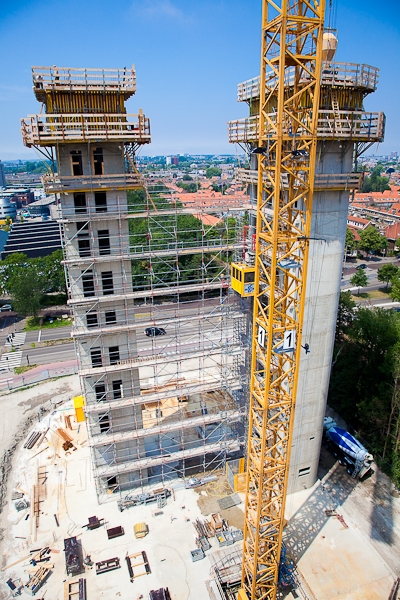Recycling and reuse in the construction sector
Earlier, we discussed developments in the field of sustainability within the construction sector and what this means for the production and use of roof access hatches. This time, we have chosen to focus on another trend within Corporate Social Responsibility (CSR), namely recycling and reuse, and how these two aspects manifest themselves in the construction sector.
Of course, recycling is by no means a new or unknown concept. However, up until now, and in any case within the construction sector, the focus has been on recycling raw materials. The next aim was to use natural raw materials in the manufacturing of products and materials, a process known as 'ecological construction'. These two methods have now been combined with a third: converting traditional raw materials into high-quality materials and products that have a long service life and which can be easily reused. This combination is known as the 'circular economy':
The circular economy is an economic system aimed at maximizing the reusability of products and raw materials while minimizing value destruction. This is in contrast to the linear system, in which raw materials are converted into products that are destroyed at the end of their service life.
An important part of the circular system is that the design of the product consider the product's final usage phase. By also ensuring that these products can be disassembled, materials can be easily separated from each other when needed. Additionally, the basic principle does not ride on purely recycling raw materials, but aiming for complete product reuse – and if this is not possible, then efforts are made to reuse the product's components. Construction and demolition waste have always been an interesting area in terms of recycling, because their relatively high metal content means that they can generate savings compared with ore extraction. It's no wonder, then, that at least 95% of construction and demolition waste is either reused or recycled.
Circular construction
In addition to their recyclable properties, construction materials are also very well suited to the circular system as described above – something that clients, designers, builders, and manufacturers have cottoned on to. This explains why manufacturers are increasingly being requested to create products that can be easily disassembled after being installed in the building. These are products that can be reused after the use phase of the building, or products of which all components can be reused. The construction sector is a frontrunner in conserving raw materials, says TNO (the Netherlands Organisation for applied scientific research TNO) in its research entitled 'Resources for our future' (2013). However, the transition from a linear to a circular system is not yet complete. The report 'Circular construction: the foundation under a modernized sector' provides a description of how this could be implemented.
Roof access hatches & Recycling
For Staka, the developments in the field of recyclability and reuse guided us in our choice to use stainless steel – an easily recyclable material – as a basis material during the design phase of our roof access hatches. More than 80% of scrapped stainless steel is recycled, and this percentage is increasing. In addition to this, we have designed a strong construction for our roof access hatches that incorporates easily disassembled and replaceable components. The construction also predominantly consists of components that are fixed to each other in such a way that they can be easily replaced. This not only fits in with the circular principle, as product components can be reused, but is also in line with what we want to achieve from a production perspective. Constructing products according to a modular design, as it were, results in countless advantages within our production process. Of course, we focus on using sustainable materials in our roof access hatches, and ensure that the roof access hatches perform optimally in terms of thermic insulation, so that we remain trendsetters in focus areas within the field of sustainability.

- 2025 © STAKA Bouwproducten B.V.
- PostAds
- All rights reserved.

 UK
UK Nederlands
Nederlands Deutschland
Deutschland US
US La France
La France


